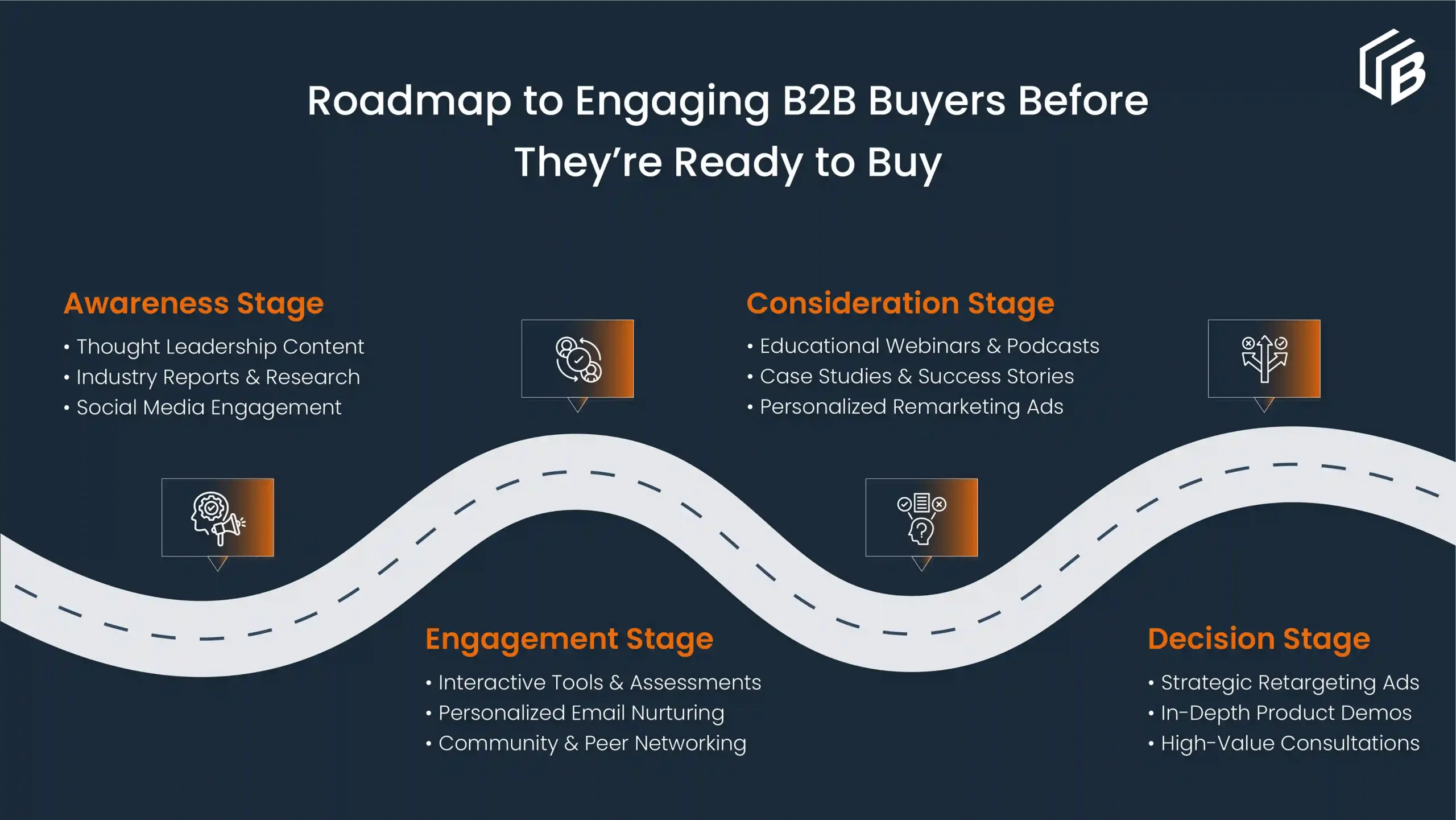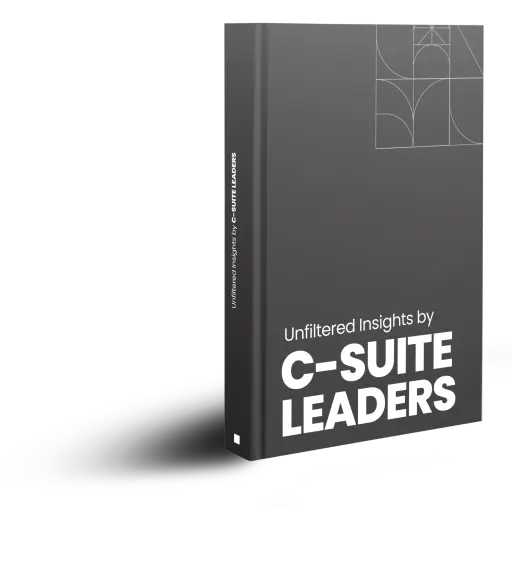
In B2B marketing, not every potential buyer is ready to purchase today. The 95/5 rule in B2B marketing highlights this reality, showing that most buyers are out-market at any given time.
While only a small percentage of your audience is actively looking to buy, the vast majority are future opportunities waiting to be cultivated. Successfully engaging this larger group requires a strategic approach, focusing on brand awareness, education, and relationship-building. It’s not just about immediate sales, it’s about planting seeds that will grow into strong business opportunities over time.
The 95/5 Rule: A Heuristic Framework or a Data-Driven Reality?
The 95/5 rule in B2B marketing is not just a rough estimate. Research with the Ehrenberg-Bass Institute reinforces this concept with concrete examples. Studies show that 95% of businesses are not actively seeking new enterprise software at any given time, yet when they enter the market, they choose brands they recognize and trust.
Similarly, cloud services and logistics industries operate on long procurement cycles, where decisions are made only after extensive research and vendor evaluation. This highlights that most of the time, B2B buyers are out-of-market, making long-term brand awareness crucial.
Despite this, many marketers believe that B2B advertising should generate immediate results. In a LinkedIn study, 96% of B2B marketers expected their B2B advertising campaigns to show a significant impact within two weeks. This belief is a myth.
Advertising often works by creating a lasting brand impression well before buyers are in the market. The key is to advertise primarily to the out-market audience, linking your brand to relevant buying situations so that when prospects do enter the market, your brand is the one they remember.

The Challenge of Engaging and Creating Demand Among the 95% of B2B Buyers
Engaging the 95% of B2B buyers who aren’t ready to purchase poses significant challenges for marketers. One of the primary obstacles is staying relevant to an audience that is not actively seeking solutions.
Without an immediate buying intent, these potential customers are more likely to overlook traditional sales-driven messages. Another challenge lies in building brand awareness and trust without appearing overly aggressive.
There’s also the difficulty of maintaining consistent engagement over extended sales cycles, which requires sustained efforts in content creation, retargeting, and thought leadership. Additionally, marketers must find a balance between providing value and not exhausting the audience with irrelevant or overly frequent messaging.
Finally, measuring success with this group is complex, as standard sales metrics may not reflect the true impact of demand generation strategy. Instead, engagement metrics such as content interaction, webinar attendance, and gradual lead scoring become critical indicators of progress in nurturing long-term opportunities.
How SDRs Can Leverage the 95/5 Rule to Create Demand
Sales Development Representatives play a critical role in driving demand among the B2B buyers who are not yet ready to purchase. Instead of traditional sales tactics, SDRs need to focus on building trust, educating prospects, and positioning the brand for future opportunities.
The goal is to guide non-buyers through the early stages of the buying journey, setting the stage for future sales.
Advanced Strategies for SDRs:
- Map Content to Pain Points: Use data-driven insights to match educational content with specific challenges prospects may face, offering tailored solutions that build credibility.
- Pre-Qualify with Insightful Conversations: Rather than pushing for a sale, ask open-ended questions that uncover business needs, timelines, and potential obstacles.
- Lead with Value, Not Discounts: Instead of offering promotions, share value-driven resources like whitepapers, industry reports, and strategic playbooks.
- Stay at Peak: Use a mix of outreach methods like emails, social media, and even direct mail, to maintain a light but consistent brand presence.
- Use Behavioral Triggers: When prospects engage with content (e.g., download a whitepaper or attend a webinar), follow up with relevant insights that move them closer to considering your solutions.
- Foster a Two-Way Dialogue: Encourage prospects to share their goals and challenges, which helps in tailoring future interactions to their specific needs.
- Implement Strategic Drip Campaigns: Develop nurturing sequences that gradually introduce more decision-stage content as engagement increases.
- Score and Segment Leads: Track engagement metrics to differentiate between highly engaged prospects and those who need more nurturing.
Strategic Framework for B2B Demand Generation: Capturing vs. Creating Demand
B2B buyers don’t make purchasing decisions overnight. Let’s take a look at the Implications of it:
- Focusing only on capturing demand means competing for a small pool of active buyers, leading to high cost-per-acquisition (CPA) and intense competition.
- Investing in demand creation ensures brand salience so when the 95% move into the buying stage, your company is the first they consider.
1. Demand Capture (Engaging the 5% of Active Buyers)
Demand capture targets prospects who are already searching for a solution and are in the consideration or decision-making phase. The goal is to remove friction, accelerate conversions, and optimize sales efficiency.
Key Demand Capture Tactics:
1.1 High-Intent Paid Search & SEO
- Prioritize bottom-funnel, high-intent keywords (e.g., “best [product category] for [industry]”).
- Develop dedicated landing pages that directly address buyer pain points.
- Implement Google Search Ads, LinkedIn Sponsored Content, and intent-driven retargeting to capture existing demand.
- Optimize for review sites (G2, Capterra, TrustRadius) where B2B buyers conduct research.
Impact: Ensures visibility where buyers are actively looking for solutions.
1.2 Competitor & Category-Based Content
- Publish detailed competitor comparison pages (e.g., “[Your Solution] vs. [Competitor]”).
- Create ROI calculators and total cost of ownership (TCO) models that demonstrate financial benefits.
- Showcase industry-specific use cases and success stories to align with buyer needs.
Impact: Helps buyers make an informed decision faster.
1.3 Conversion-Optimized Website & Lead Magnets
- Implement AI-driven chatbots and interactive demos for frictionless lead capture.
- A/B test landing page copy, CTAs, and forms to improve conversion rates (CVR).
- Offer instant booking for sales calls and personalized content recommendations based on buyer behavior.
Impact: Reduces drop-off and accelerates pipeline velocity.
1.4 Intent-Based Retargeting Ads
- Retarget website visitors with case studies, product demos, or testimonials instead of generic ads.
- Use LinkedIn Matched Audiences & Google Display Network to re-engage prospects who have interacted with your content.
- Personalize messaging based on buying stage and industry to increase engagement.
Impact: Keeps your brand at a high level as prospects finalize decisions.
1.5 Sales Acceleration Through Personalization
- Use ABM to identify high-intent accounts and tailor outreach.
- Leverage buyer intent data from platforms like Bombora to prioritize outreach.
- Personalize outbound efforts with LinkedIn InMails, custom video pitches, and executive insights.
Impact: Ensures sales teams engage with the highest-value prospects efficiently.
2. Demand Creation (Creating Awareness Among 95% of Non-Buyers)
Demand creation focuses on building brand awareness and credibility among the 95% who are not actively looking for a solution today, but will be in the future. The goal is to educate, engage, and position your brand as the go-to authority so that when they enter the buying stage, your company is already at the top.
Key Demand Creation Tactics:
2.1 Build an Industry Resource Hub
Create a dedicated content hub with high-value resources, including:
- Industry reports & benchmarks
- Webinars & expert interviews
- Frameworks, playbooks, and templates
- Offer gated and ungated content to balance lead capture with organic reach.
Impact: Establishes thought leadership and consistently attracts non-buyers.
2.2 Community-Driven Engagement
- Launch LinkedIn Groups, Slack Communities, or exclusive roundtable discussions for industry peers.
- Host Q&A sessions with experts to facilitate ongoing engagement.
- Leverage executives and subject matter experts (SMEs) as brand ambassadors on social platforms.
Impact: Positions your brand as an industry facilitator, not just a vendor.
2.3 Offer Free Tools & Diagnostic Solutions
- Develop calculators, scorecards, or automation templates that solve common pain points.
- Example: A ROI estimator for marketing attribution software or a security risk assessment tool for cybersecurity vendors.
- Promote tools via LinkedIn Ads, email nurturing, and influencer partnerships.
Impact: Creates daily utility for prospects, increasing brand recall.
2.4 Host Virtual Roundtables & Podcasts
- Organize invite-only executive roundtables on emerging trends.
- Launch a podcast series featuring industry leaders discussing key challenges.
- Repurpose content into snackable LinkedIn posts, YouTube shorts, and blog recaps to extend reach.
Impact: Drives engagement and positions your brand as a category authority.
2.5 Value-First Retargeting & Brand Awareness Ads
- Instead of product ads, run thought-leadership ads featuring research insights, industry trends, or case studies.
- Use video ads on LinkedIn & YouTube to educate rather than sell.
- Shift ad spend toward non-converting but engaged audiences for long-term brand reinforcement.
Impact: Builds trust and nurtures long-term relationships.
Key Takeaways: Balancing Demand Capture & Demand Creation
| Strategy | Target Audience | Primary Goal | Typical Channels |
| Demand Capture | Active buyers (5%) | Convert existing demand | Google Ads, SEO, Retargeting, Sales Outreach |
| Demand Creation | Future buyers (95%) | Build brand affinity & awareness | LinkedIn, Content Marketing, Community Building |
Why You Need Both:
- Short-Term Revenue (Demand Capture): Ensures you’re converting high-intent buyers efficiently.
- Long-Term Growth (Demand Creation): Ensures future buyers associate your brand with expertise when they enter the market.
- Competitive Differentiation: Companies that only capture demand end up in a price war; companies that create demand build a brand moat.
Recommended Approach:
- 70% Investment in Demand Creation: Focus on prioritizing brand awareness, market education, and prospect nurturing through webinars, social media promotions, industry reports, and educational content.
- 30% Investment in Demand Capture: Optimize for conversion by leveraging SEO, PPC, and sales enablement strategies to capture active buyers. This includes paid search campaigns, intent-driven content, retargeting, and equipping sales teams with high-impact collateral.
Most B2B companies over-invest in demand capture and under-invest in demand creation, leading to short-term wins but long-term pipeline stagnation. The brands that win in the long run are those that build demand before they need it.

How We Can Help You in the Demand Creation?
UnboundB2B can help you tap into the 95% of the market that isn’t ready to buy yet by offering strategic resources and building brand awareness long before purchase intent arises.
Alongside as a brand you can focus on providing educational content and value-driven resources rather than direct sales messaging. Use call-to-actions that encourage learning, such as “Discover Best Practices” or “Learn How Industry Leaders Solve This Problem,” to build trust and engagement.
As it is said, a strong strategy is using gated assets for strategic planning, nurturing long-term relationships, and positioning your brand as a trusted advisor. UnboundB2B emphasizes rethinking marketing through the “in-market/out-market” approach. Hence, creating brand impressions early so buyers remember you when they’re ready. Rather than chasing quick wins, the focus is on staying visible, providing value, and becoming the go-to brand when the time is right.
Want to ensure your brand stays top-of-mind when buyers are ready? Let’s connect and explore how UnboundB2B can support your demand generation goals.
Tracking and Improving Engagement: How to Nurture Future B2B Buyers
Engaging future buyers isn’t just about keeping your brand visible, it’s about creating meaningful connections that pay off when they finally enter the market. The goal is to blend genuine engagement with strategic follow-up, ensuring your brand is ahead when it’s go-time for them. Here’s how to track and nurture engagement effectively:
- Follow the Breadcrumbs: Use analytics to track which content prospects engage with—whether it’s webinar attendance, blog views, or whitepaper downloads. Understand what resonates most, helping you fine-tune your messaging and offer more of what your audience craves.
- Score Leads Beyond the Obvious: Implement a lead scoring model that considers not just purchase intent but also content interactions and engagement patterns. This approach helps prioritize leads who may not be ready to buy but are showing signs of interest, keeping your pipeline warm.
- Craft Personalized Drip Campaigns: Develop email sequences that serve up valuable content, from strategic insights to success stories, without pushing a hard sell. This strategy builds trust over time and ensures prospects see your brand as a helpful resource, not just a seller.
- Adapt and Refine Your Approach: Regularly analyze engagement data to identify trends and adjust your demand generation strategy accordingly. This keeps your marketing agile, ensuring you’re always aligned with the evolving needs and interests of your audience.
Conclusion: Planting the Seed for Future Sales
Engaging the 95% of buyers who aren’t ready to purchase today is about playing the long game. It requires a strategic approach that combines value-driven content, patient nurturing, and consistent brand presence.
When B2B marketers adapt the 95/5 rule, they can build a robust pipeline, ensuring their brand is not only remembered but also trusted when prospects are ready to buy. The key takeaway is clear: investing in the 95% now means reaping the rewards of future sales success.
Our blog
Latest blog posts
Tool and strategies modern teams need to help their companies grow.

It is for fact that today's buying environment demands more. With longer sales cycles...

To build a marketing strategy that drives real results, you need more than creative i...

Running a business comes with its own set of challenges, especially when it comes to ...







